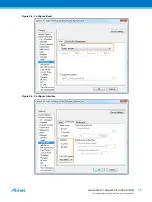
4.3.2.
Virtual COM Port
The Embedded Debugger acts as a Virtual Com Port gateway by using one of the ATSAMD11D14A
UARTs. For further information on how to use the Virtual COM port see
Table 4-8. Virtual COM Port Connections
Pin on SAM D11
Function
PA10
SERCOM2 PAD[2] UART TXD (SAM D11 TX line)
PA11
SERCOM2 PAD[3] UART RXD (SAM D11 RX line)
4.3.3.
Atmel Data Gateway Interface
The Embedded Debugger features an Atmel Data Gateway Interface (DGI) by using either a SPI or I²C
port. The DGI can be used to send a variety of data from the SAM D11 to the host PC. For further
information on how to use the DGI interface see
.
Table 4-9. DGI Interface Connections When Using SPI
Pin on SAM D11
Function
PA27
GPIO/SPI SS (Slave select) (SAM D11 is Master)
PA09
SERCOM0 PAD[3] SPI MISO (Master In, Slave Out)
PA06
SERCOM0 PAD[0] SPI MOSI (Master Out, Slave in)
PA07
SERCOM0 PAD[1] SPI SCK (Clock Out)
Note:
1.
PA27 is shared between SPI SS to the EDBG and VBUS detect on target USB. This is
implemented so the pin can detect if VBUS is present when configured as input with no internal
pull. If VBUS is present, the level on the pin will be high. If VBUS is not present, the line is
externally pulled low. It will not be possible to detect this if the EDBG SPI DGI interface is enabled
from Atmel Data Visualizer.
Table 4-10. DGI Interface Connections When Using I²C
Pin on SAM D11
Function
PA08
SERCOM2 PAD[0] SDA (Data line)
PA09
SERCOM2 PAD[1] SCL (Clock line)
Four GPIO lines are connected to the Embedded Debugger. The EDBG can monitor these lines and time
stamp pin value changes. This makes it possible to accurately time stamp events in the SAM D11
application code. For further information on how to configure and use the GPIO monitoring features see
.
Table 4-11. GPIO Lines Connected to the EDBG
Pin on SAM D11
Function
PA16
GPIO0
PA17
GPIO1
PA14
GPIO2
PA15
GPIO3
Atmel SAM D11 Xplained Pro [USER GUIDE]
Atmel-42349B-SAM-D11-Xplained-Pro_User Guide-04/2016
14










































